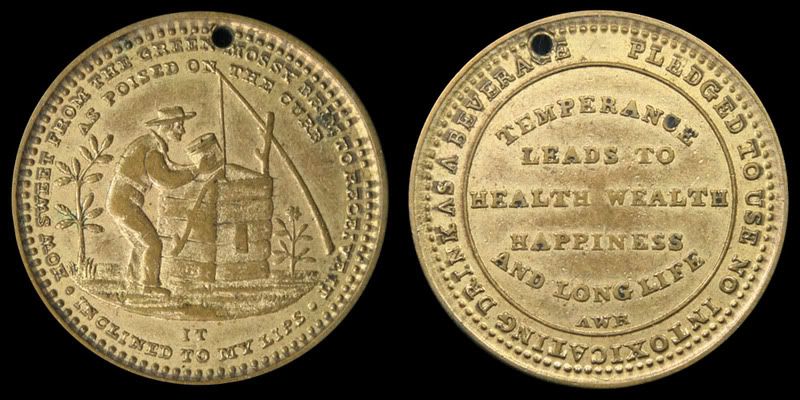Temperance medal.
Here's something I inherited about 20 years ago when my grandmother died. To the best of my knowledge she never collected coins, so I'm assuming my grandfather collected them (he died before I was born). Anyhow, here's a temperance medal that I think is pretty neat. The image was taken by Bruce Lee, and I think he did an excellent job.

Edited to add: Does anyone have any information on this piece? If so, that would be great.

Edited to add: Does anyone have any information on this piece? If so, that would be great.
0
Comments
It is a very nice specimen of a medal by James Bale, a prominent diesinker of New York City, likely struck in the early 1840s. It looks to be brass, like most of Bale's temperance issues. His initial "B" can be seen at the base of the well, on the obverse of your specimen...
...I only had room to devote a paragraph to temperance medals in my book, and to illustrate just a few of the types discussed below, but I find them fascinating and think they should get more exposure. From my upcoming Whitman book, A Guide to U.S. Tokens and Medals:
Temperance societies pledged to end the use of alcohol, and issued holed tokens for their members to wear pinned to their lapels, or to take home as souvenirs of society functions and anniversaries. The medals and tokens of the Washington Temperance Societies usually bore renditions of the first president. The earliest temperance pieces were struck in the 1830s by James Bale (alone, and in his partnership with Frederick B. Smith), and featured a scene of a man retrieving fresh water from a well with the “old wooden bucket.” In 1919, while federal legislators were debating passage of the Volstead Act, coin dealer Thomas L. Elder (who fervently hoped for a dry nation) exhibited 250 examples of temperance medals and tokens before the New York Numismatic Club. Elder held more than 50 varieties of the well-and-bucket type, signed by various die sinkers including Benjamin True and Joseph F. Thomas, and issued by several temperance societies including the National Christian Temperance Union, the Total Abstinence Society, and The Cold Water Army. Several varieties struck for the Catholic Temperance Society bore a portrait of its leader, Father Matthew. One token of 1855 depicted an upside-down wineglass. Others showed fountains spewing water, and most bore some version of the pledge WE AGREE TO ABSTAIN FROM THE USE OF ALL INTOXICATING LIQUORS AS A BEVERAGE. Some included an escape clause: "EXCEPT FOR MEDICINAL PURPOSES"... I believe your token is the second one pictured in the article. Elder lists its diameter as 24 mm, and gives it a rarity rating of R1: that is, common.
Another Bale temperance piece is described in one of Rich Hartzog's catalogs (exonumia.com). Here he refers to a recent article on the subject that I have not seen, but solves the mystery of the initials AWR on your piece. Please note that Hartzog's catalog entry refers to pieces signed "B & S, NY" which dates them to Bale's partnership with Frederick B. Smith:
1449. NY Old Oaken Bucket Temperance Medals, 1841. The origin of these medals was not known until Spencer Radnich published a twenty-eight page paper on them in the Oct. 2004 TAMS Journal. They were issued by Ashbel Wells Ridley of Rochester, New York, who was General in the New York State Militia. The dies were cut by Bale and Smith. Temperance slogan in very small letters around man drawing water from a well using the "old oaken bucket" (hence the name of the medal) / "I Pledge to Use No Intoxicating Drink as a Beverage" around "Temperance Leads to Health, Wealth, Happiness and Long Life, A. W. R." Not in Rulau. Three pieces, 24 mm, gilt copper or gilt brass. XF to Uncirculated. $30.00-35.00+ ...
U.S. Type Set
What is now proved was once only imagined. - William Blake
U.S. Type Set
U.S. Type Set
Article on the Washingtonians
This group was essentially the Alcoholics Anonymous of its day, and practiced many of the same principals central to AA today. However, unlike AA, they became involved in political issues of the day (abolition in particular). The lack of focus on their primary purpose (ie - getting drunks sober) resulted in the society's demise.
Interestingly, the fate of the Washingtonians became a subject of great interest to Alcoholics Anonymous in the first 10 years after its inception - as AA grew in the 1940s, the society experienced a fair amount of turmoil, much of which was due to the same sort of pressures that tore the Washingtonians apart.
Some time is the early to mid-40s, an article about the Washingtonians was sent to Bill Wilson, one of the founders of AA. The person who sent it to him suggested that AA was traveling the same path as the Washingtonians and would become a footnote in a history book somewhere if measures weren't taken to reign the fledgling organization in. In response to this, Wilson developed what he called "the 12 Traditions" of AA, which are widely credited with getting the society back on course during a difficult time. These traditions are still central to the way that AA is run today, steering it away from unnecessary controversy and keeping its focus on what it was originally intended to do - helping alcoholics stop drinking.
Just another example of numismatics (or in this case exonumia) and history intersecting.
What is now proved was once only imagined. - William Blake